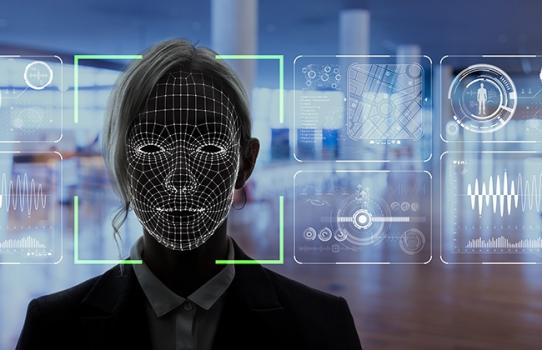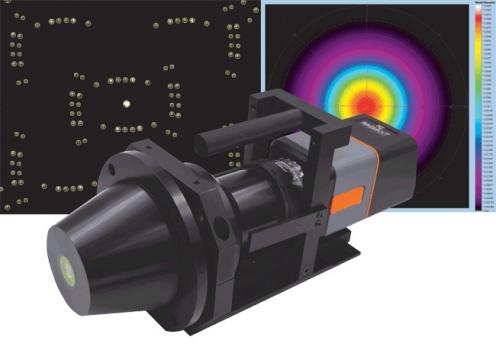Facial Recognition Safety Just Got Easier
Description
When it comes to facial recognition, safety is the priority. The near-infrared (NIR) light used for mapping can be potentially harmful if the wavelengths are not at safe and sufficient levels of radiant intensity. Because of this, it is critical to precisely measure the emitted light. Traditionally, NIR measurements were taken with goniometric equipment. While certainly accurate, this equipment can be bulky and expensive and require time-consuming work. Radiant Vision Systems has developed a solution to this problem with the introduction of the Near-Infrared Intensity Lens. We sat down with Jens Jensen, director of product development at Radiant Vision Systems, to get the scoop on how this measurement lens can ensure safety with minimal time and cost.
NED: Can you explain what the Near-Infrared (NIR) Intensity Lens is and why it is needed in the market?
JJ: The NIR Intensity Lens is the first commercially-available Fourier optic solution applied for NIR light source measurement. The lens uses Fourier optics to transform angular emissions of light onto a CCD sensor to create a 2D image of the 3D light output from the NIR light source. Near-infrared light is ideal for facial recognition because it is invisible to the human eye, making it unnoticeable when cast into a user’s face. Proper filtering can remove the visible light spectrum, increasing the reliability of facial sensing in ambient light conditions. However, because they are not perceived by human vision, measuring the emissions from NIR light sources (such as NIR LEDs and lasers) is critical for safe and accurate 3D sensing performed by NIR-based facial recognition devices.
The NIR Intensity Lens solution measures these NIR light sources to ensure that emissions are within safe and sufficient levels of radiant intensity. The lens also analyzes output uniformity of the light and ensures emissions or structured light patterns are properly distributed to provide the necessary information for NIR sensing devices, which interpret NIR light reflected from 3D objects. Applications in consumer electronics, automotive, and aerospace may rely on NIR light for 3D sensing like facial recognition for privacy or awareness monitoring, and gesture recognition for multi-modal device control. Optical design engineers and manufacturing test engineers may employ solutions like the NIR Intensity Lens for design and quality control of these NIR-sensing devices.
NED: What are the main features of the Intensity Lens?
JJ: The key features of the lens include a wide angular field of view, which allows it to capture light emitted at angles out to 70-deg. from the perpendicular. A full “cone” of light to +/-70-deg. can be analyzed at once, using Fourier optics of the lens to capture this light data in a single 2D image. Alternative solutions for light measurement typically apply goniometric equipment, which is bulky and expensive and can take much longer to complete a measurement because it takes a one at each angle by rotating the light in front of a photodetector. The NIR lens can acquire comparable measurement data about a NIR light source in a single image capture and analysis.
Another feature of the NIR Intensity Lens solution is its high angular resolution, which is up to 0.05-deg. per CCD pixel. This is possible thanks to the high resolution of the integrated imaging radiometer, which has a 16-megapixel CCD sensor.
Lastly, the software that is paired with the NIR Intensity Lens provides analysis functions that make NIR light measurement extremely efficient. Especially for structured light patterns produced by diffractive optical elements, or DOE. These components refract a single laser beam of NIR light into tens of thousands of individual emission points (like dots on a grid). These patterns are cast onto 3D objects to sense the objects’ curvature. The NIR solution software can dynamically locate all of the thousands of emission points produced by the light source, within 3D space. The software creates points of interest around each dot and outputs comprehensive statistics about each dot and the entire pattern.
NED: What is your favorite feature and why?
JJ: The big advantage of this one-shot system is the ability to add angular inspection to a production line and give 100% inspection of all components in any device. Devices or NIR sources do not need to be rotated in front of the NIR Intensity Lens to acquire comprehensive, angular data, enabling production applications that require minimal adaptation by the customer. Comprehensive NIR light evaluation is, of course, required for meeting the safety regulations surrounding NIR-emitters. But acquiring the complete details about the source (such as all the statistical data output by the Radiant system) will likely derive new applications of the technology because more information about the source is much more readily available to the customer for consideration.
NED: In pilot projects, what data supported that the NIR Intensity Lens would be useful?
JJ: The compact system allows immediate, full-featured analysis of quality while simultaneously measuring the eye safety aspect of a new component, per standards like those governed by IEC. This is extremely useful for both Radiant and for the customer, as the ability to provide a single-system, single-image analysis of a NIR sample increases the efficiency of applying a measurement solution in terms of cost, speed, footprint, and system integration versus traditional measurement methods.
NED: What challenges did you come across when developing the lens?
JJ: The NIR Intensity Lens system was developed over a number of years, finally being released this year in 2019. Radiant’s engineering team made incremental improvements to the system to address new customer requirements to address the efficiency with which we are able to obtain comprehensive data from a NIR source. There was no ideal solution for NIR source measurement, especially when you consider the range of manifestations of NIR light for 3D sensing applications like facial and gesture recognition. Some devices accomplish NIR sensing by shining LEDs in angular space at a source, requiring angular measurement to a number of degrees in each direction. Some NIR sensing is accomplished by what we call “flood sources,” which diffuse the NIR light through a filter, which may have hot spots or various fall-off points in terms of intensity across the diffused area. NIR sensing can also be accomplished using structured light patterns, which require analyzing tens of thousands of emission points in a given pattern. All of these measurement scenarios are accommodated by the NIR Intensity Lens solution, capturing all data in a single image and outputting analytical data for the given source in about a minute.
Originally a visible light and optical measurement company, Radiant had to expand our wavelength range into the NIR range to address these light sources used in non-visible light sensing. Previously, we worked vigorously on eliminating all NIR radiation from each measurement to ensure the accuracy of data in the visible spectrum. Now, our expertise has extended to qualifying and quantifying the NIR radiation outside of the visible spectrum. This allows us to offer a much broader range of light measurement options and allow us to build our experience toward addressing new applications of light technology.
NED: Can you tell us something interesting about it we won’t find on your website?
JJ: An interesting feature of this solution for our users is the ability to really tailor the solution—especially the software—to the needs of their application. You can set regions of interest across structured light patterns, like those produced by DOE, to analyze all emitted dots at once, or each dot separately, or draw your own special regions of interest to analyze groups of dots in different areas. Users can select several tests to run against the measured light source data, which can run back to back in sequence on a single image, making a full light source analysis extremely fast. For instance, I can set a software test sequence to run an overall radiant intensity measurement, then from the same image look at uniformity for intensity hot spots, and then run a Time of Flight (TOF) analysis to determine the light output from various emission angles or regions.
NED: Anything else you’d like to add readers might find interesting?
JJ: Fourier optics are extremely useful for capturing angular data (in 3D space) and translating these to 2D images for spatial analysis on a single plane. Beyond near-infrared light source measurement, Fourier optics are also applied for visible light and color measurement. A Fourier optic lens, like a conoscope, can be positioned in front of a display – for instance – to get an accurate view of a single point as seen from every vantage point in a 60-degree rotation, all in a single image. This is especially useful for view angle measurement of displays, such as in automotive console displays where angular visibility of display information is critical, and Radiant provides an FPD (flat panel display) conoscope lens for this type of measurement as well.



